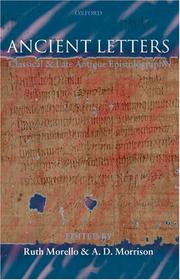| Listing 1 - 6 of 6 |
Sort by
|

ISBN: 9780199203956 0199203954 0191708240 9786611148683 0191525359 1281148687 1435621085 Year: 2007 Publisher: Oxford: Oxford university press,
Abstract | Keywords | Export | Availability | Bookmark
 Loading...
Loading...Choose an application
- Reference Manager
- EndNote
- RefWorks (Direct export to RefWorks)
The surviving body of ancient letters offers the reader a stunning variety of material, ranging from the everyday letters preserved among the Oxyrhynchus papyri to imperial rescripts, New Testament Epistles, fictional or pseudepigraphical letters and a wealth of missives on almost every conceivable subject. They offer us a unique insight into ancient practices in the fields of politics, literature, philosophy, medicine and many other areas. This collection presents a series of casestudies in ancient letters, asking how each letter writer manipulates the epistolary tradition, why he chose the l
Latin letters --- Letter writing, Latin --- Authors, Latin --- Statesmen --- Lettres (Genre littéraire) latines --- Correspondance latine --- Ecrivains latins --- Hommes d'Etat --- History and criticism. --- History. --- Correspondence --- Histoire et critique --- Histoire --- Correspondance --- History and criticism --- History --- Lettres (Genre littéraire) latines --- Public officers --- Latin letter writing --- Latin letters - History and criticism --- Letter writing, Latin - History --- Authors, Latin - Correspondence - History and criticism --- Statesmen - Rome - Correspondence - History and criticism --- Lettres (genre littéraire) antiques --- Auteurs latins --- Auteurs grecs
Book
ISBN: 9789004202344 900420234X Year: 2011 Volume: 329 Publisher: Leiden: Brill,
Abstract | Keywords | Export | Availability | Bookmark
 Loading...
Loading...Choose an application
- Reference Manager
- EndNote
- RefWorks (Direct export to RefWorks)
Science, Ancient --- Natural history --- Sciences anciennes --- Sciences naturelles --- Pliny, --- Pliny, - the Elder. - Naturalis historia
Book
ISBN: 9780521603799 0521842921 9780521842921 9781139024747 052160379X 1139334042 1107225647 1139337416 9786613571786 1139339869 1139341448 1139338285 1139024744 1139336541 1280393866 9781139338288 9781139336543 9781139339865 9781107225640 9781139334044 9781280393860 6613571784 9781139337410 9781139341448 Year: 2012 Publisher: Cambridge ; New York : Cambridge University Press,
Abstract | Keywords | Export | Availability | Bookmark
 Loading...
Loading...Choose an application
- Reference Manager
- EndNote
- RefWorks (Direct export to RefWorks)
This is the first general introduction to Pliny's Letters published in any language, combining close readings with broader context and adopting a fresh and innovative approach to reading the letters as an artistically structured collection. Chapter 1 traces Pliny's autobiographical narrative throughout the Letters; Chapter 2 undertakes detailed study of Book 6 as an artistic entity; while Chapter 3 sets Pliny's letters within a Roman epistolographical tradition dominated by Cicero and Seneca. Chapters 4 to 7 study thematic letter cycles within the collection, including those on Pliny's famous country villas and his relationships with Pliny the Elder and Tacitus. The final chapter focuses on the 'grand design' which unifies and structures the collection. Four detailed appendices give invaluable historical and scholarly context, including a helpful timeline for Pliny's life and career, detailed bibliographical help on over 30 popular topics in Pliny's letters and a summary of the main characters mentioned in the Letters.
Brevskrivning --- Letter writing, latin --- Letter writing, latin. --- Ancient, classical & medieval. --- Plinius, --- Plinius Caecilius Secundus, Gaius, --- Correspondence (Pliny, the Younger). --- Literary collections --- Historia. --- History --- Pliny, --- Criticism and interpretation. --- Criticism, Textual. --- Antiken. --- To 1500. --- Arts and Humanities --- Letter writing, Latin --- Plinius Caecilius Secundus, Gaius --- Gaius Plinius Secundus Minor --- C. Plini Caecili Secundi --- Pline le Jeune --- Plinius de jongere --- Plinius der Jüngere --- Caius Plinius, --- Gaĭ T︠S︡et︠s︡iliĭ Pliniĭ Sekund, --- Gaj Plinije, --- Kaĭ Pliniĭ T︠S︡et︠s︡iliĭ Vtoroĭ --- Pline, --- Pliniĭ, --- Plinio, --- Plinius Caecilius Secundus, C. --- Plinius Caecilius Secundus, Caius --- Plinius, Caius,
Book
ISBN: 128312095X 9786613120953 9004210075 9789004210073 9781283120951 9789004202344 900420234X Year: 2011 Publisher: Leiden Boston
Abstract | Keywords | Export | Availability | Bookmark
 Loading...
Loading...Choose an application
- Reference Manager
- EndNote
- RefWorks (Direct export to RefWorks)
Pliny's Naturalis Historia – a brilliant and sophisticated encyclopaedia of the scientific, artistic, philosophical, botanical and zoological riches of the ancient world – has had a long career in the footnotes of historical studies. This is a phenomenon born of the sense that the work was there to consult, or to ‘use’, as a resource to aid investigation of specific technical issues or passages, of Quellenforschung, or of delimited topic areas. The contributors to the present volume both represent and join a new generation of critics who have begun to try to ‘read’ this monumental text, and – by examining the dominant motifs which give shape and order to the work – to construct frameworks within which we may understand and interpret Pliny’s overarching agenda.
Digital
ISBN: 9781139024747 Year: 2012 Publisher: Cambridge Cambridge University Press
Abstract | Keywords | Export | Availability | Bookmark
 Loading...
Loading...Choose an application
- Reference Manager
- EndNote
- RefWorks (Direct export to RefWorks)
Digital

ISBN: 9783111308128 9783111308494 9783111306995 Year: 2023 Publisher: Berlin ;; Boston De Gruyter
Abstract | Keywords | Export | Availability | Bookmark
 Loading...
Loading...Choose an application
- Reference Manager
- EndNote
- RefWorks (Direct export to RefWorks)
| Listing 1 - 6 of 6 |
Sort by
|

 Search
Search Feedback
Feedback About UniCat
About UniCat  Help
Help News
News